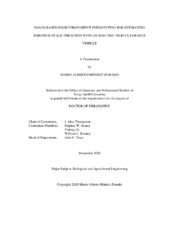| dc.contributor.advisor | Thomasson, John A | |
| dc.creator | Méndez Dorado, Mario Alberto | |
| dc.date.accessioned | 2021-05-11T02:15:44Z | |
| dc.date.available | 2022-12-01T08:19:08Z | |
| dc.date.created | 2020-12 | |
| dc.date.issued | 2020-11-23 | |
| dc.date.submitted | December 2020 | |
| dc.identifier.uri | https://hdl.handle.net/1969.1/192983 | |
| dc.description.abstract | This research presents the development of two imaging systems capable of estimating stalk thickness of sorghum plants as well as the design, validation, construction and testing of an electric ground phenotyping vehicle (EGPV) able to carry sensors aimed at high-throughput phenotyping (HTP) on mature energy sorghum and corn. The first imaging system was developed with a low-cost RGB camera with an integrated infrared time-of-flight sensor to measure distance. The system captured images of eight energy sorghum plants on a weekly basis for six weeks under greenhouse conditions. The images were postprocessed off-line with k-means and minimum distance classification methods and visually inspected. The user then manually selected the stalk center, an image-processing algorithm was used to estimate stalk thickness, and estimates were compared to manual caliper measurements. The best estimates were found based on the k-means classification method and explained 70% of the variability in the caliper data, with a root mean squared error (RMSE) of 3.19 mm. The second imaging system was developed with a high-precision stereo camera (STR) and mounted on a high clearance vehicle to record video images of mature sorghum plants under field conditions. The STR images were postprocessed to compute depth maps. The user then selected two locations on the stalk in the images, another image-processing algorithm was used to estimate stalk thickness, and estimates were again compared to manual caliper measurements. The STR estimates explained 81% of variation in the caliper data, with an RMSE of 1.87 mm.
The EGPV was designed and constructed in order to clear 3-m tall mature energy sorghum plants, planted at 76.2-cm or 101.6-cm furrow spacing. The design was validated with finite element analysis, assuming a factor of safety of 4.0 or higher, corresponding to the design of static structures or machine elements under dynamic loading with significant uncertainty in the stress analysis relative to the application. The maximum theoretical speed of the vehicle was found to be 6 km/h, falling in the range of 5 to 9 km/h of most agricultural machinery operations. The vehicle’s minimum turning radius during testing at 3 m was measured.
In summary, two imaging systems were designed and tested for estimating stalk thickness of energy sorghum plants. One performed reasonably well under greenhouse conditions, and the other, a stereo-camera system, performed well under field conditions. The stereo vision system was tested on a high clearance vehicle, and it is ultimately intended to be integrated with the EGPV (autonomous high-clearance phenotyping vehicle) as a semiautomatic tool for HTP under field conditions, specifically for assessing biomass content in sorghum or corn plants, and eliminating the tedious tasks of measuring and registering by hand. | en |
| dc.format.mimetype | application/pdf | |
| dc.language.iso | en | |
| dc.subject | stalk thickness | en |
| dc.subject | high-throughput phenotyping | en |
| dc.subject | imaging systems | en |
| dc.subject | electric ground phenotyping vehicle | en |
| dc.title | Image-Based High-Throughput Phenotyping for Estimating Sorghum Stalk Thickness with an Electric High-Clearance Vehicle | en |
| dc.type | Thesis | en |
| thesis.degree.department | Biological and Agricultural Engineering | en |
| thesis.degree.discipline | Biological and Agricultural Engineering | en |
| thesis.degree.grantor | Texas A&M University | en |
| thesis.degree.name | Doctor of Philosophy | en |
| thesis.degree.level | Doctoral | en |
| dc.contributor.committeeMember | Searcy, Stephen W | |
| dc.contributor.committeeMember | Ge, Yufeng | |
| dc.contributor.committeeMember | Rooney, William L | |
| dc.type.material | text | en |
| dc.date.updated | 2021-05-11T02:15:45Z | |
| local.embargo.terms | 2022-12-01 | |
| local.etdauthor.orcid | 0000-0002-8704-3817 | |


